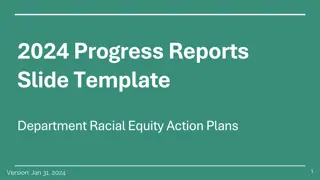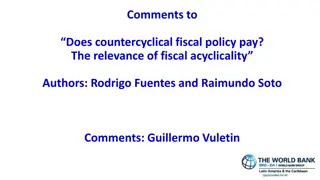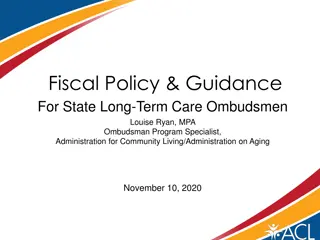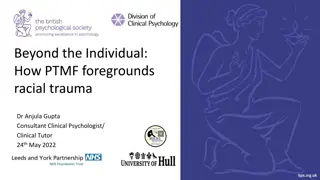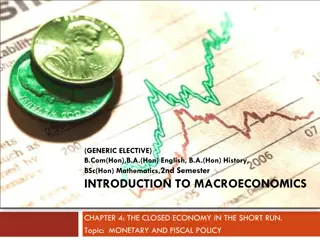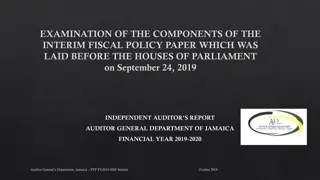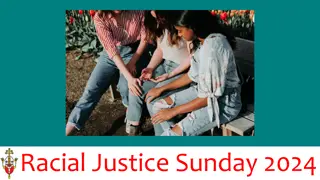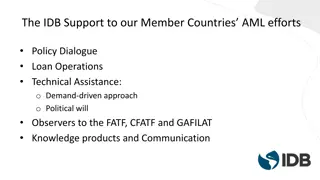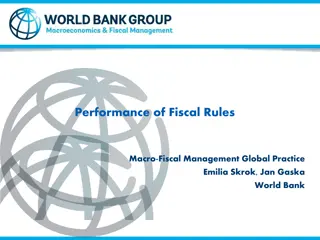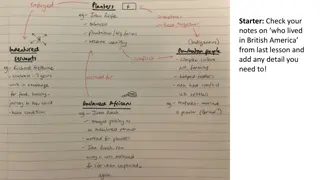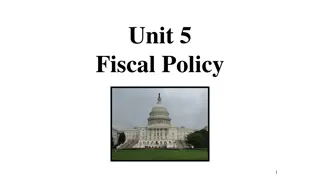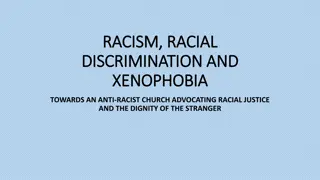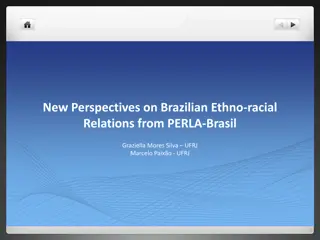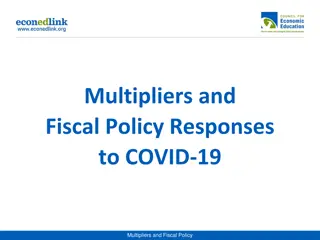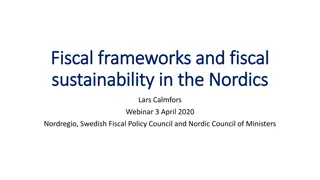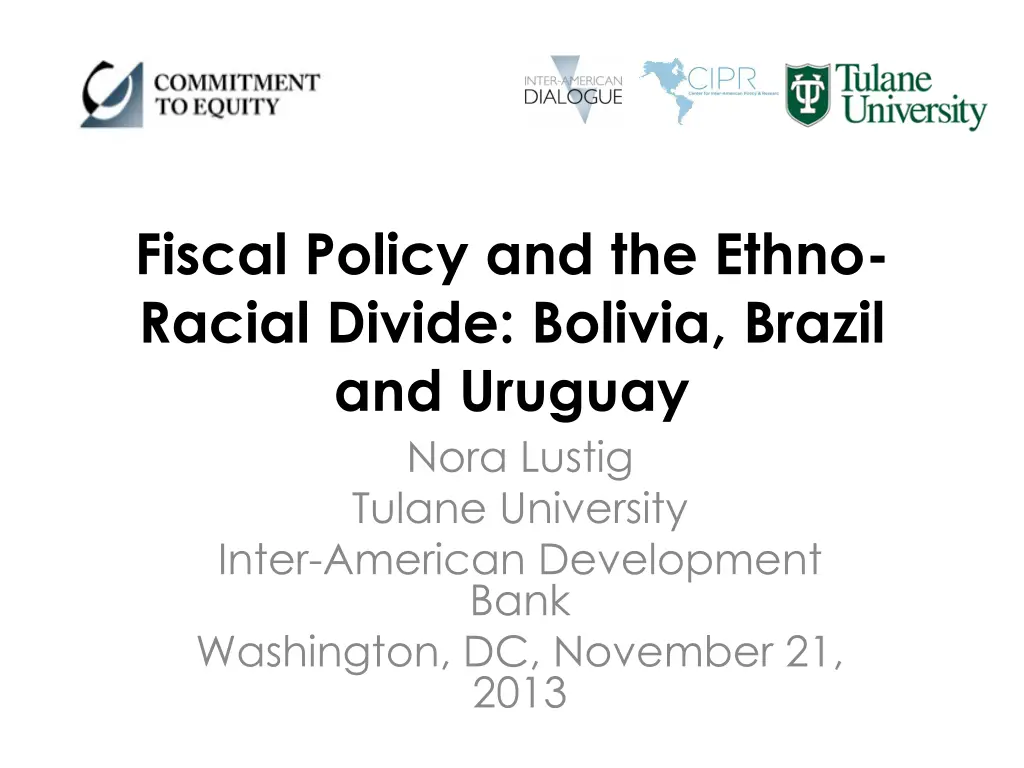
Fiscal Policy and Ethno-Racial Divide: Insights from Bolivia, Brazil, and Uruguay
Explore the impact of fiscal policy on ethno-racial disparities in Bolivia, Brazil, and Uruguay through measures of equity, poverty, and inequality. Learn about the commitment to equity, budget composition, Gini coefficient, poverty rates, and more in this comprehensive analysis.
Download Presentation

Please find below an Image/Link to download the presentation.
The content on the website is provided AS IS for your information and personal use only. It may not be sold, licensed, or shared on other websites without obtaining consent from the author. If you encounter any issues during the download, it is possible that the publisher has removed the file from their server.
You are allowed to download the files provided on this website for personal or commercial use, subject to the condition that they are used lawfully. All files are the property of their respective owners.
The content on the website is provided AS IS for your information and personal use only. It may not be sold, licensed, or shared on other websites without obtaining consent from the author.
E N D
Presentation Transcript
Fiscal Policy and the Ethno- Racial Divide: Bolivia, Brazil and Uruguay Nora Lustig Tulane University Inter-American Development Bank Washington, DC, November 21, 2013
Commitment to Equity (CEQ) www.commitmentoequity.org 2
CEQ by Ethnicity and Race Bolivia: Paz-Arauco, Grey-Molina, Jimenez and Ya ez Brazil: Higgins and Pereira Guatemala: Cabrera, Lustig and Moran (under verification) Uruguay: Bucheli, Rossi and Amabile
Budget Size and Composition Primary and Social Spending as % of GDP 5
Fiscal Policy and Inequality Gini Coefficient by Income Concept 0.59 0.57 0.55 Bolivia 0.53 Brazil Chile 0.51 Colombia 0.49 Costa Rica 0.47 Guatemala Mexico 0.45 Paraguay 0.43 Peru Uruguay 0.41 0.39 Market Income Net Market Income Disposable Income Post-Fiscal Income Final Income 6
Fiscal Policy and Poverty Headcount Ratio Poverty Rate at $4 PPP/day for Each Income Concept (Pensions included in Market Income) 40.0% 35.0% 30.0% 25.0% Argentina (2009) Bolivia (2009) Brazil (2009) 20.0% Mexico (2010) Peru (2009) 15.0% Uruguay (2009) 10.0% 5.0% 0.0% Market Income Net Market Income Disposable Income Post-Fiscal Income 7
Measuring the Ethno-Racial Divide 1. Poverty: poverty rates by ethnic and racial groups and the ethno-racial composition of the poor 2. Inequality: ratio of income per capita between and the distribution of population within groups 3. Inequality of opportunity: a measure of equalization of incomes across circumstances 4. Equity in Public Services: use of public education and health services by ethnic and racial groups
Poverty Headcount Ratio US2.50ppp/day 30.00% 25.00% 20.00% Boliva Non-Indigenous Boliva Indigenous Brazil White 15.00% Brazil Pardo Uruguay White Uruguay Afro-Descendants 10.00% 5.00% 0.00% Market Net Market Disposable Post-fiscal
Ethno-Racial Composition of the Population by Income Class (thresholds from Ferreira et al., 2013) 100% 90% 80% 70% 60% Bolivia Non-Indigenous Bolivia Indigenous 50% Brazil White Brazil Pardos 40% Uruguay White Uruguay Afrodesc 30% 20% 10% 0% less 1.25 1.25 - 2.50 2.50 - 4.00 4.00 - 10.00 10.00 - 50.00 more 50.00 Total
Ethno-Racial Composition of the Population by Income Class Market and Disposable Income 0% 10% 20% 30% 40% 50% 60% 70% 80% 90% less 1.25 1.25 - 2.50 Bolivia Indigenous Pre-fisc 2.50 - 4.00 Bolivia Indigenous Post-fisc Brazil Pardos pre-fisc 4.00 - 10.00 Brazil Pardos Post-fisc Uruguay Afrodesc Pre-fisc Uruguay Afrodes Post-fisc 10.00 - 50.00 more 50.00 Total
Ratio of Income Per Capita Between Ethno-Racial Groups 2.01 1.95 2.05 1.70 1.68 1.62 1.55 1.52 1.52 Market Income Disposable Income Post-Fiscal Income BOLIVA Nonind/Indig BRAZIL White/Afrodes URUGUAY White/Afrodes
Distribution of the Population by Income Class (thresholds from Ferreira et al., 2013) 70% 60% 50% Bolivia Nonindigenous 40% Bolivia Indigenous Brazil White Brazil Pardos 30% Uruguay White Uruguay Afrodesc 20% 10% 0% less 1.25 1.25 - 2.50 2.50 - 4.00 4.00 - 10.00 10.00 - 50.00 more 50.00
Distribution of the Population by Income Class Market and Disposable Income more 50.00 10.00 - 50.00 Uruguay Afrodesc Post-fisc 4.00 - 10.00 Uruguay Afrodesc Pre-fisc Brazil Pardos Post-fisc Brazil Pardos pre-fisc 2.50 - 4.00 Bolivia Indig Post-fisc Bolivia Indig Pre-fisc 1.25 - 2.50 less 1.25 0% 5% 10% 15% 20% 25% 30% 35% 40% 45% 50%
Equalizing Opportunities 0.12? 0.1? 0.08? BOLIVIA? 0.06? BRAZIL? URUGUAY? 0.04? 0.02? 0? Market? Net? Market? Disposable? Post-fiscal? Final?
Assessing Characteristics of Fiscal Interventions Progressivity: Taxes: Progressive if share paid is higher than market income share for ethno-racial group with higher per capita income Regressive if share paid is higher than market income share for ethno-racial group with lower per capita income
Assessing Characteristics of Fiscal Interventions Progressivity: Transfers: Progressive if share received is higher than market income share for ethno-racial group with lower per capita income Progressive in absolute terms if share received is higher than population share for ethno-racial group with lower per capita income Regressive if share received is lower than market income share for ethno-racial group with lower per capita income
BOLIVIA POPULATION NONINDIGENOUS INDIGENOUS 46% 54% MARKET? INCOME 57% 43% All? Direct? ? Transfers 39% 61% Non-contributory? Pensions Flagship? CCT Other? Direct? Transfers 39% 61% 39% 61% 44% 56% Indirect? Subsidies Indirect? Taxes Net? Indirect? Taxes 57% 43% 56% 44% 56% 44% Education 48% 52% Education:? YSP Education:? preschool Education:? primary Education:? secondary 23% 77% 40% 60% 40% 60% 41% 59% 40% 60% ? all? except? tertiary Education:? tertiary Education:? PAN 60% 40% 40% 60% Health 45% 55% Cajas Public? Healt? System 53% 47% 43% 57%
BRAZIL WHITE AFRODESCENDANTS Population 48.0% 64.9% 50.8% 33.5% Market? Income 71.4% 27.5% Direct? Taxes Direct? Taxes? and? Contributions? to? Soc? Sec 70.5% 27.7% 55.1% 44.2% All? Direct? ? Transfers 26.6% 72.3% CCT 72.2% 27.4% Scholarships Special? Circumsta Unemployment? B 64.5% 50.5% 34.7% 48.9% 51.9% 47.6% Other? Direct? Tran Indirect? Taxes Net? Indirect? Transfers 64.5% 64.7% 43.5% 39.1% 39.6% 40.4% 33.9% 34.1% 55.0% 59.9% 59.4% 58.5% Education Education:? preschool Education:? primary Education:? secondary Education:? all? except? tertiary Education:? tertiary 39.7% 59.3% 59.6% 37.1% 44.5% 54.3% ? Health Educ,? Health? plus? Housing? and? Urban 44.0% 54.7%
WHITE AFRODESCENDANT URUGUAY %? nat'l 95.5% 97.2% 97.6% 92.8% 91.9% 92.5% 93.3% 97.3% 97.3% 95.4% 94.9% 94.1% 95.9% 98.5% 94.9% %? nat'l 3.4% 1.9% 1.7% 5.8% 6.7% 6.2% 5.3% 1.9% 1.9% 3.7% 4.3% 4.9% 3.2% 0.9% 3.9% POPULATION MARKET? INCOME Direct? Taxes All? Direct? ? Transfers CCT Non-contributory? pension Other? Direct? Transfers Indirect? Taxes Net? Indirect? Taxes In-kind? Education Education:? preschool Education:? primary Education:? secondary Education:? tertiary In-kind? ? Health
Assessing Characteristics of Fiscal Interventions Scale Effect For poor population: Coverage Per capita transfers Horizontal inequity For poor population: Incidence of a transfer (tax) higher (lower) for ethno-racial group with lower poverty rates
Bolivia: Post-Fiscal Income wrt Market Income Incidence'of'Post5 Fiscal'Income:'Bolivia'' 20.0%& Percent'of'Market'Income'' 15.0%& 10.0%& 5.0%& 0.0%& !5.0%& !10.0%& y& <& 1.25& 1.25& <& =& y& <& 2.50& 2.50& <=& y& <& 4.00& 4.00& <=& y& <& 10.00& 10.00& <=& y& <& 50.00& 50.00& <=& y& Income'Group' Na/onal& Non!Indigenous& Indigenous& Source: Paz-Arauco et al., 2013 CEQ-IDB.
Why Ethno-Racial Divide is not Reduced More in Bolivia? The indigenous population has a higher coverage rate and receives a higher per capita transfer on average than the nonindigenous. The largest transfer program in terms of its budget is Renta Dignidad, a noncontributory universal pension for all citizens over 60 years old; in 2009 (year of the survey), this program represented 1.4 percent of GDP (Table Bolivia-8). Because the transfer under this program is practically the same in per capita terms for all individuals of the eligible age, its concentration coefficient is around zero (Figure Bolivia-2).
Why Ethno-Racial Divide is not Reduced More in Bolivia? In other words, the universal nature of the largest cash transfer in Bolivia is one of the reasons why the cash transfers programs are not able to do more to reduce the ethnic divide in terms of poverty rates and the large presence of the indigenous population among the poor.
Why Ethno-Racial Divide is not Reduced More in Bolivia? This is particularly so because Bolivia does not have large-scale anti-poverty programs (such as Bolsa Familia and Oportunidades). In fact, leaving out Renta Dignidad and Benemeritos, the government spends a paltry of .31 percent of GDP in cash transfers (Bono Juancito Pinto and Bono Juana Azurduy) and .21 percent on school feeding programs. Clearly, children are getting the short- end of the stick in Bolivia.
Why Ethno-Racial Divide is not Reduced More in Brazil?
Why Ethno-Racial Divide is not Reduced More in Brazil? Special Circumstances Pensions include social protection programs against illness, disability, widowhood, orphanhood and other adverse shocks that, although they are paid through the formal social security system to which beneficiaries need to be enrolled, individuals can be eligible to receive the benefit even if they have not made contributions to the system (see Table Brazil-8 for a brief description of cash transfers).
Why Ethno-Racial Divide is not Reduced More in Brazil? Special Circumstances Pensions Coverage: is higher for the white population and especially so among the poorest groups. The per capita benefit is also higher for the white population as a whole and all income groups, including the poorest. The white population also benefits more from the Scholarships program primarily because the average per capita transfer is higher. The poorer groups among the white population have not only higher per capita transfers but also higher coverage.
Brazil: Post-Fiscal Income wrt Market Income
Uruguay: the Poster Child Measured in terms of outcomes, direct taxes and cash transfers reduce quite a bit the ethno-racial divide in Uruguay in the (disposable) income space. While poverty rates remain lower for the white population, the distance is shortened substantially. Also, the nonwhites are no longer overrepresented among the ultra-poor and a notable share of the Afrodescendants is moved from the poor to the vulnerable and middle income class.
Uruguay There are no visible ethno-racial inequities in health spending except those related to quality. In education, the inequity is probably associated with higher repetition rates among the nonwhites as well as a lower access to tertiary education.

